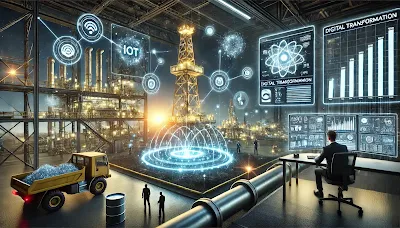The oil and gas industry is at a critical crossroads. With increasing pressure to enhance efficiency, reduce costs, and meet sustainability goals, companies are turning to digital transformation to revolutionize operations. Technologies like IoT (Internet of Things) sensors, predictive maintenance, and data analytics are reshaping the sector, creating the modern "digital oilfield"—a connected, data-driven environment that maximizes production while minimizing risks.
The Digital Oilfield: A Revolution in Progress
The concept of the digital oilfield is not new, but its adoption has accelerated dramatically in recent years. According to a report by MarketsandMarkets, the global digital oilfield market is expected to grow from $28.5 billion in 2020 to $40.4 billion by 2025, driven by advancements in automation, cloud computing, and artificial intelligence (AI).
What is a Digital Oilfield?
A digital oilfield leverages real-time data from IoT sensors, machine learning algorithms, and advanced analytics to optimize drilling, production, and asset management. By integrating these technologies, companies can achieve:
- Higher operational efficiency
- Lower maintenance costs
- Improved safety and environmental compliance
- Increased production output
Real-World Example: Preventing a Catastrophic Equipment Failure
In 2018, a major oil company deployed IoT sensors on its offshore drilling rigs to monitor equipment health in real-time. One of the sensors detected abnormal vibrations in a key pipeline valve, signaling a potential failure. Using predictive analytics, engineers determined that the valve was likely to fail within 48 hours. The company immediately scheduled maintenance, avoiding what could have been a multi-million-dollar production shutdown and potential environmental disaster.
IoT in Oil & Gas: The Game Changer
IoT in oil and gas is redefining how companies collect and use data. By embedding sensors across wells, pipelines, and refineries, businesses can monitor performance, track emissions, and even predict future failures before they happen.
Key Use Cases of IoT Sensors:
-
Equipment Health Monitoring
- Sensors continuously track temperature, pressure, and vibration in critical machinery.
- Early warnings prevent costly breakdowns and extend equipment life.
-
Remote Pipeline Surveillance
- Smart sensors detect leaks and structural weaknesses in pipelines.
- AI-driven models analyze historical data to predict future failures.
-
Reservoir Optimization
- IoT devices measure reservoir pressure and fluid composition in real-time.
- Smart drilling adjustments maximize extraction efficiency.
Case Study: How BP Saves $100 Million Annually with IoT
British Petroleum (BP) has integrated IoT technology across its global operations. By using real-time data analytics and machine learning, BP has cut unplanned downtime by 35% and saved over $100 million annually on maintenance and operational costs.
Predictive Maintenance: Cutting Costs & Boosting Efficiency
Traditional maintenance in oil and gas has been either reactive (fixing something after it breaks) or scheduled (routine check-ups regardless of actual need). Enter predictive maintenance, which uses IoT and AI to forecast failures before they occur.
How Predictive Maintenance Works:
- Sensors gather real-time equipment data (e.g., temperature, pressure, vibration).
- AI models analyze trends and detect early warning signs of failure.
- Maintenance is scheduled only when necessary, reducing costs and downtime.
The Cost-Saving Potential
According to Deloitte, predictive maintenance can reduce oil and gas operational costs by up to 30% and extend equipment life by 20%-40%. For large operators, this translates to savings in the hundreds of millions per year.
Success Story: Shell’s AI-Powered Predictive Maintenance
Shell has implemented AI-driven predictive maintenance across its refineries and offshore platforms. By leveraging IoT data, Shell has reduced maintenance costs by 20% and improved production efficiency by 10%—adding billions to its bottom line.
The Future of Digital Transformation in Oil & Gas
The digital transformation journey is just beginning. Future advancements in AI, blockchain, and robotics will further reshape the oil and gas sector. Companies that embrace these innovations will gain a competitive edge, while those that resist may struggle to keep up.
Looking Ahead: What’s Next?
- AI-powered drilling optimization for increased recovery rates
- Autonomous robotic inspections to improve worker safety
- Blockchain for transparent supply chain management
- Advanced emission tracking to meet sustainability goals
Conclusion
The oil and gas industry is evolving, and digital transformation is no longer optional—it’s essential. The integration of IoT, predictive maintenance, and data analytics is enabling companies to cut costs, improve efficiency, and ensure safer operations. As technology continues to advance, the digital oilfield will become the standard, driving the future of energy production.
For more insights on the latest oil and gas innovations, subscribe to Oilfield Intel and stay ahead of the curve.

Comments
Post a Comment